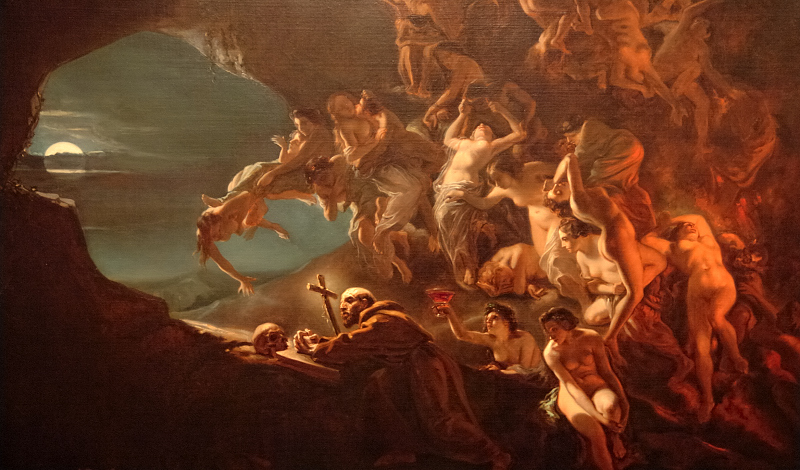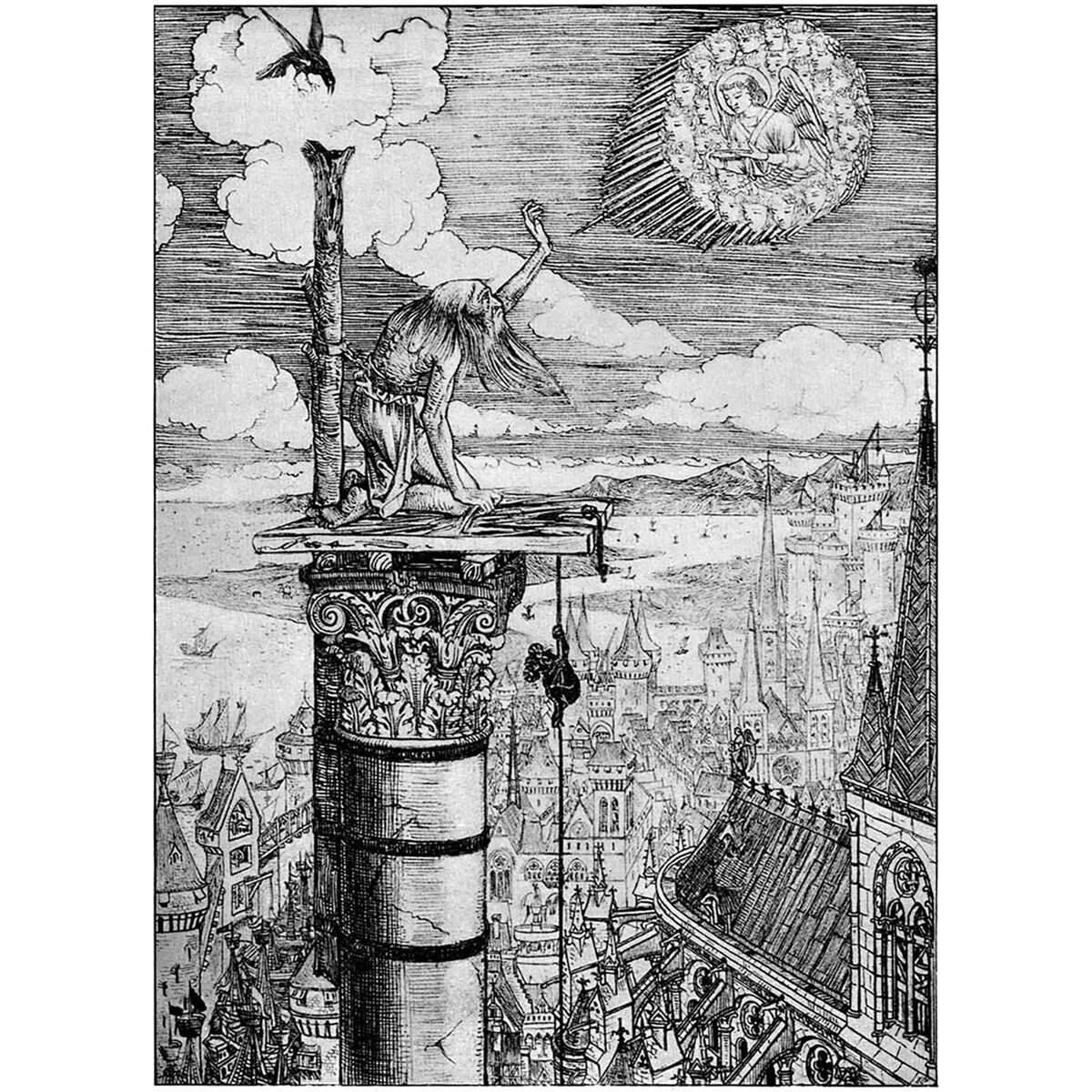The image you just clicked is an image of a medieval christian hermit known as an anchorite. It is a painting by Teodor Axentowicz

"Anchorite" or "anchoress" is the word for people, typically Christian people, who seperate themselves from "secular society" to focus more on their spirituality and their god. They typically lived isolated lives within a sealed off room besides a church.


Male Christian hermits typically outnumbered female Christian hermits, according to the written documentation we have today. But from the 12th to the 16th century, anchoresses outnumbered anchorites. In the 13th century, anchoresses outnumbered anchorites four to one.

British anchorites were mostly dissolved after the 1530s, when the Anglican church dissolved most the British monasteries.

The anchorite tradition most likely stems from the practices of the
Desert Fathers, a group of monks who lived in the deserts of the Egytian parts of the Roman Empire. They were founded by the venerated saint, Paul of Thebes (Paul the First Hermit, Paul the Anchorite), who alledgedly went out into the desert at sixteen and lived to one hundred and thirteen.

Paul fled into the desert, away from the persecutors of his faith and his brother-and-law, and deposited himself into a cave. He lived in this cave for the rest of his life. Sometimes a raven would fly by and give him food. When he was a old man, Anthony the Great (Anthony of Egypt, Anthony the Abbot, Anthony the Anchorite, Anthony of Thebes, Father of All Monks) came to visit him because he heard about him in a dream. Not long after, Paul died. Anthony buried him with the help of two lions (apparently). Afterwards, Anthony lived as Paul lived and drew literally hundreds of followers into the desert. At one point, these Desert Fathers were called "a city in the desert."

The word "hermit" can actually be traced back the greek word
eremos, which means desert.

The pagan hagiographer and rhetorician, Eunapius of Sardis, described the early Eastern Christian monks as "men in appearance, but [who] led the lives of swine."

Scholarly critic, Henry Chadwick, had this to say when discussing the Desert Hermits: "The ascetic ideal makes people so otherworldly as to be of no use in this world."

The Desert Fathers were formed in a pre-Christianized Roman Empire, a time that drove many to the fringes of society. They were mainly Coptics, or Christian Egyptians.

In ancient Egyptian literature, the ideal of the "(truly) silent man" was prominent. Various aspects of this "silence" were conceived by the Egyptians in terms of "good manners," and in the word "gr" or "self-control." There's lots of evidence to suggest that the anchorite traditions weren't just rooted in Christian traditions, but Egyptian ones as well. There are other histories of Egyptian ascetics, going back as far as 300 BCE, such as Amoun the Hermit, who also went into the desert.

On the traditions of the Coptic monks, historian Jeffrey Conrad, writes: "While prayer was most often done alone, the hjsuciva [meditation] was practiced with the intent of seeking the advice of an Abba. Sitting in his cell, the lonely ascetic would meditate, paying close attention to the thoughts that ran through his mind. Many times his streams of consciousness, or logismoiv, would be puzzling, and often disturbing. Every so often, the ascetic would go to an Abba, to help him analyse his thoughts."

Numerous Christian hermits are commemorated via the well known sayings (apophthegmata) of the Desert Fathers. The alphabetical collection is known as the
Apophthegmata Patrum.

On the day of his death, Anthony is reported to have said to his disciples: "Live as if you were going to die every day, devoting attention to yourselves."
In the apophthegmata, Saint Anthony "is depicted as a penitent, unlettered Egyptian peasant, who is plagued by his conscience fled into the demon-haunted desert," according to religion scholar, Samuel Rubenson.


A photo of a monostary of St. Anthony in Egypt.

As was shown with Anthony and Paul, many documented Christian anchorites and hermits are classified as saints, with quite a few designated as
"St. So-and-so the Hermit."

Saint Hilarion was born sometime in 290 five miles south of Gaza. He "believed in the Lord Jesus, and delighted neither in the madness of the circus, in the blood of the arena, or in the luxury of the theatre: but all his heart was in the congregation of the Church." When he was fifteen, he walked, basically naked, into the desert to be with the Desert Fathers. He experienced a life of "spiritual dryness that included temptations to despair" and was visited by "demons night and day." He was a prominent basket-weaver and sage, and lots of people visited him for advice. He was a faith healer as well.


The Temptation of Saint Hilarion by Octave Tassaert

Saint Simeon Stylites was a Syrian monk who was born in 390 with "an exaggerated sense of sinfulness and an exaggerated ambition of saintly honour." He was famous for sitting on top of a pillar. He was a very intense sixteen year old at the monastery. He moved into a tiny hut at the base of a mountain. Eventually, he found an old pillar in the ruins of a nearby village, built a fence around it, and decided to live on top of it for the rest of his life. He might have lived off food that was brought up to him via a pulley system.


A 1861 illustration of St. Simeon by Frederick Holleyer

Simeon apparently got up on that pillar because he was tired of people approaching him for advice and healing. "When, therefore, they came innumerable (for all tried to touch him, and receive some blessing from those skin garments of his), thinking it in the first place absurd and unfit that such exceeding honour should be paid him, and next, disliking the labour of the business, devised that station on the pillar, bidding one be built, first of six cubits, then of twelve, next of twenty-two, and now of thirty-six. For he longs to fly up to heaven, and be freed from this earthly conversation."

During the Syrian Civil War, in May 2016, St. Simeon's pillar was destroyed by an airstrike from the Russian Air Force.

















 A photo of a monostary of St. Anthony in Egypt.
A photo of a monostary of St. Anthony in Egypt.



 The Temptation of Saint Hilarion by Octave Tassaert
The Temptation of Saint Hilarion by Octave Tassaert






